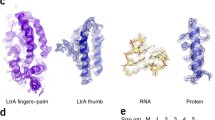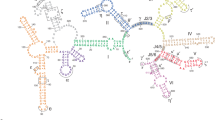Abstract
GROUP II introns, which are classed together on the basis of a conserved secondary structure1, are found in organellar genes of lower eukaryotes and plants. Like introns in nuclear pre-messenger RNA, they are excised by a two-step splicing reaction to generate branched circular RNAs, the so-called lariats2. A remarkable feature of group II introns is their self-splicing activity in vitro3–6. In the absence of a nucleotide cofactor, the intron RNAs catalyse two successive transesterification reactions which lead to autocatalytic excision of the lariat IVS from pre-mRNA and concomitantly to exon ligation. By virtue of its ability to specifically bind the 5' exon7, the intron can also catalyse such reactions on exogenous RNA substrates8. This sequence-specific attachment could enable group II introns to integrate into unreá-lated RNAs by reverse splicing, in a process similar to that described for the self-splicing Tetrahymena group I intron9. Here we report that group II lariat IVS can indeed reintegrate itself into an RNA composed of the ligated exons in vitro. This occurs by a process of self-splicing that completely reverses both transesterification steps of the forward reaction: it involves a transition of the 2'–5' phosphodiester bond of the lariat RNA into the 3'–5' bond of the reconstituted 5' splice junction.
Similar content being viewed by others
References
Michel, F. & Dujon, B. EMBO J. 2, 33–38 (1983).
Sharp, P. A. Science 235, 766–771 (1987).
Peebles, C. L. et al. Cell 44, 213–223 (1986).
Van der Veen, R. et al. Cell 44, 225–234 (1986).
Schmelzer, C. & Schweyen, R. J. Cell 46, 557–565 (1986).
Schmelzer, C. & Müller, M. W. Cell 51, 753–762 (1987).
Jacquier, A. & Michel, F. Cell 50, 17–29 (1987).
Muller, M. W., Schweyen, R. J. & Schmelzer, C. Nucleic Acids Res. 16, 7383–7395 (1988).
Woodson, S. A. & Cech, T. R. Cell 57, 335–345 (1989).
Jarrell, K. A., Peebles, C. L., Dietrich, R. C., Romiti, S. L. & Perlman, P. S. J. biol. Chem. 263, 3432–3493 (1988).
Lambowitz, A. M. Cell 56, 323–326 (1989).
Wolf, K. & Del Guidice, L. Endocyt. C. Res. 4, 103–120 (1987).
Michel, F. & Lang, B. F. Nature 316, 641–643 (1985).
Sharp, P. A. Cell 42, 397–400 (1985).
Cech, T. R. Int. Rev. Cytol 93, 3–22 (1985).
Author information
Authors and Affiliations
Rights and permissions
About this article
Cite this article
Augustin, S., Müller, M. & Schweyen, R. Reverse self-splicing of group II intron RNAs in vitro. Nature 343, 383–386 (1990). https://doi.org/10.1038/343383a0
Received:
Accepted:
Issue Date:
DOI: https://doi.org/10.1038/343383a0
- Springer Nature Limited
This article is cited by
-
GC clusters and the stability of mitochondrial genomes ofSaccharomyces cerevisiae and related yeasts
Folia Microbiologica (2002)
-
Retrotransposition of a bacterial group II intron
Nature (2000)
-
Inside an intron invasion
Nature (1996)
-
Organization of the histone H3 genes in soybean, barley and wheat
Molecular and General Genetics MGG (1996)
-
Mobile group II introns, DNA circles, reverse transcriptase and senescence
Genetica (1994)





